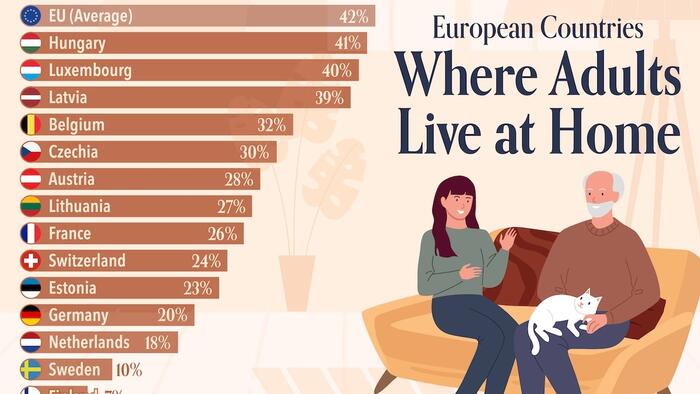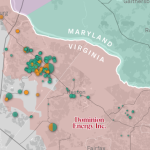This graphic ranks European countries by the percentage share of those 25–29 years old living with their parents, as sourced from Eurostat (2023).
Importantly, as Visual Capitalist’s Pallavi Rao explains below, part of the metric tracked is “persons benefiting from or contributing to the household income.”
This means that cases where adult children support aging parents are also factored into this dataset.
Where Do Europeans Adults Live With Their Parents?
In Croatia and Montenegro, nearly 80% of adults aged 25–29 adults live at home. Interestingly, in neighboring Serbia this metric drops to 69%.
| Rank | Country | % of those aged 25–29 living with parents |
|---|---|---|
| 1 | 🇭🇷 Croatia | 79% |
| 2 | 🇲🇪 Montenegro* | 79% |
| 3 | 🇮🇹 Italy | 70% |
| 4 | 🇸🇰 Slovakia | 70% |
| 5 | 🇷🇸 Serbia* | 69% |
| 6 | 🇬🇷 Greece | 69% |
| 7 | 🇵🇱 Poland | 68% |
| 8 | 🇵🇹 Portugal | 65% |
| 9 | 🇪🇸 Spain | 64% |
| 10 | 🇧🇬 Bulgaria | 60% |
| 11 | 🇮🇪 Ireland | 56% |
| 12 | 🇸🇮 Slovenia | 55% |
| 13 | 🇷🇴 Romania | 53% |
| 14 | 🇨🇾 Cyprus | 51% |
| 15 | 🇲🇹 Malta | 49% |
| 16 | 🇭🇺 Hungary | 41% |
| 17 | 🇱🇺 Luxembourg | 40% |
| 18 | 🇱🇻 Latvia | 39% |
| 19 | 🇧🇪 Belgium | 32% |
| 20 | 🇨🇿 Czechia | 30% |
| 21 | 🇦🇹 Austria | 28% |
| 22 | 🇱🇹 Lithuania | 27% |
| 23 | 🇫🇷 France | 26% |
| 24 | 🇨🇭 Switzerland* | 24% |
| 25 | 🇪🇪 Estonia | 23% |
| 26 | 🇩🇪 Germany | 20% |
| 27 | 🇳🇱 Netherlands | 18% |
| 28 | 🇸🇪 Sweden | 10% |
| 29 | 🇳🇴 Norway | 7% |
| 30 | 🇫🇮 Finland | 5% |
| 31 | 🇩🇰 Denmark | 5% |
| N/A | 🇪🇺 EU | 42% |
*Data from 2022.
Figures rounded. Information unavailable for Iceland, UK, North Macedonia, Albania, Kosovo, and Türkiye.
Cross-referencing this dataset with the average age Europeans move out reveals correlations. A higher average moving out age corresponds with a greater percentage share of 25–29 year old adults at home.
And the Balkan countries rank in the top few spots in both. Part of it is the economy. The Balkans generally have a per-capita GDP that is half the EU average. Local rents are expensive compared to local wages.
Adding to that, the homeownership rate in the Balkans is also the highest across Europe, indicating that children inherit the family home or move out only when they can afford to buy homes themselves.
Meanwhile, in Serbia and Montenegro, nearly half the households are “financially fragile,” indicating the level of savings is also low. In such cases moving out and renting might be seen as an unaffordable luxury.
Correspondingly, as one moves north and west across to higher per capita GDPs in Europe, the share of adults living with parents drops. In the Nordics, fewer than 10% of adults in this age bracket live with their parents.
One major exception to the rule is Ireland, where more than half of those aged 25–29 still live at home.
Loading…











